Cette publication est également disponible en :
Français
On 6 June 2024, the 5th Experimental Scent Summit, organised by the Los Angeles-based Institute for Art and Olfaction, took place in Lisbon amidst the enticing aromas of pastéis de nata, flowering lime blossom and damp cobblestones. A day teeming with encounters between researchers, artists and perfumers from all over the world who shared research and ideas about olfactory culture.
After Berlin, London, Amsterdam, a virtual event in 2020 and a four-year break due to the pandemic, organisers Saskia Wilson-Brown, Klara Ravat, Julianne Lee and Miguel Matos are overjoyed to have once again gathered together a community of professional and perfume enthusiasts. Participants spent a stimulating day exploring topics as varied as transmodality in the arts, the use of aromas in Mesoamerican cultures, and fragrance compositions in the form of olfactory exquisite corpses!
Olfactory art takes pride of place
Under the golden ceiling of Casa do Alentejo at the heart of the Portuguese capital, American artist Megan Linderman got the event under way with a presentation of her project Love, Trust, and Chlorine (2024) examining the odour of oxytocin. The audience, made up of around sixty people from over a dozen different countries, got the chance to discover some surprising samples: one reproducing the “clinical yet very human” smell of oxytocin, the other straight out of the artist’s imagination, inspired by the neuropeptide nicknamed the “happiness hormone” because of the role it plays in empathy, trust and social bonding for humans. The project, which has not yet reached its final form, combines two invisible substances that move through our bodies and affect them in the same way they do our psyches. It represents the artist’s first incursion into olfactory creation.
Similarly rooted in biology, the olfactory experience proposed by perfumer Maxwell Williams and artist Sean Raspet, both from the USA, was even more disconcerting: based on research into interindividual variations in the perception of certain odiferous molecules due to the diversity of expression in genes coding the olfactory receptors involved in their reception, their fragrance Missense (2024) is composed purely of known molecules so they can be perceived in very different ways by each person. Taking the opposite path from the desire to be as universally pleasing as possible and ensure a uniform reception, Missense maximises perceptual differences and cultivates a lack of consensus. Encouraged by the artists to express their perception of the creation verbally, participants used a resolutely eclectic vocabulary in their attempts to characterise something that seemed to many of them to have “never been smelled before!”
In addition to these purely olfactory forms of creation, several other projects at the intersection of the visual, audio, performance, digital and olfactory arts were also showcased. Artist, composer and perfumer Jo Burzynska, who came all the way from New Zealand for the event, described her multi-sensorial practice based on experimenting with transmodality. The concept of transmodality, often confused with synaesthesia, consists of associating two types of stimuli, an association usually shared by a large number of individuals. “If the smell of lemon were a sound, would it be pitched high or low?” is the question the artist asked to illustrate her approach. The answer from the audience was unanimous: a lemon’s aroma is high-pitched. Listening to high-pitched notes while smelling a scented composition could therefore, in theory, boost perception of its citrusy notes. This is the logic underpinning the various projects developed by the artist, such as The Frequency Range (2023), three perfumes inspired by assorted pitches, and Scents take up the ringing (2024) combining sound, smell and colour in an exploration of the cultural notion of harmony.
Ugo Charron, French musician and perfumer at Mane, presented a different style of concept, at the crossroads of hearing, sight and the sense of smell. The immersive concerts organised by Cosmic Gardens, the electronic music duo he co-founded several years ago with Clément Mercet, shift experiences combining smell and sound from galleries and museums and into entertainment venues. The live sets are divided into several episodes powered by music as well as olfactory and visual compositions, inviting the audience on a multi-sensorial journey from the depths of the ocean to the mysteries of cosmic space.
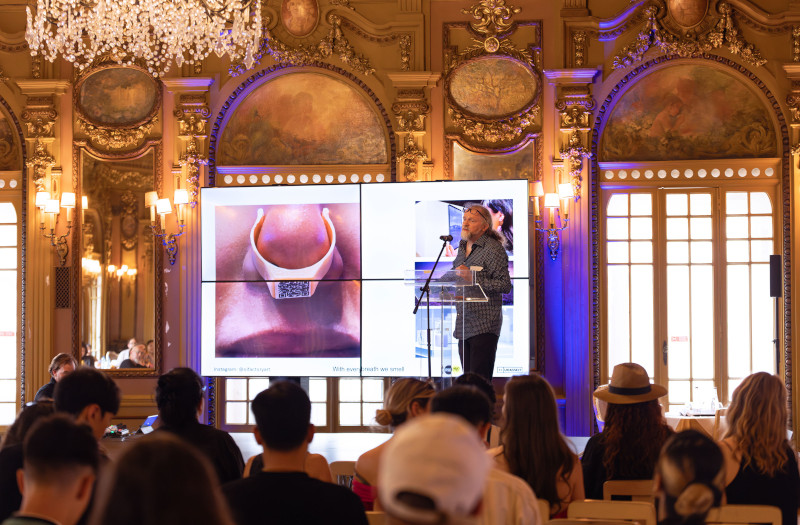
© João Inocêncio Gomes/Institute for Art and Olfaction
Belgian artist Peter de Cupere, whose inventiveness and productivity in the field of olfactory creation over the last thirty or so years are almost unmatched, chose to present several works inspired by the musical universe but without sound. One of them was Olfactiano (1997-2004), another the recent Odomonica (2023-2024), a sort of silent harmonica which, rather than producing musical notes, releases various odiferous notes activated by the player blowing on it. Then there were his recent olfactory augmented-reality works, tested by participants at the summit. His QR Nose Smeller printed in 3D and designed to be attached directly under the nostrils allows the person using it to smell a perfume at the same time as a QR code, scanned with a smartphone or tablet, triggers the display of a virtual sculpture which seems to appear in the viewer’s immediate environment. The impression of its presence is particularly realistic since the odour, perceived simultaneously, almost seems to emanate directly from it.
Artist M Dougherty illustrated their practice by exploring the possibilities of creating olfactory illusions unrelated to phantosmia, which is not an illusion but a hallucination in the form of perception of an olfactory sensation in the absence of odiferous molecules. The illusion in this case arises when stimuli and perception do not correspond: the similar perception of two different stimuli, or a different perception of similar stimuli, for example. What interests M Dougherty within this perspective is identifying by what means artists can control the olfactory perception of the people experiencing their work: orchestrating a disconnect between the sense of smell and sight, manipulating expectations and employing linguistic suggestions or masking effects are all techniques that can be used to perturb, orient or give meaning to olfactory experiences in an artistic context.
As the morning drew to a close, the room was permeated with the mingled aromas of orange, lemon and grapefruit as the audience attempted to peel the citrus fruit handed out by American artist and musician Hannah Marie Marcus. The goal? To try and detect in one of the fruits a fragrance injected into the pericarp by the artist, who chose this approach to present her project Citromancy (2023-2024). The artist created this divination ritual – meant as a playful moment – based on fresh citrus fruit reperfumed from the inside by a selection of raw materials, each associated with a specific divinatory message reproduced in the form of a poem. Does your kumquat conceal the aroma of gum cistus? The message is clear: “Be like the goat/Traverse freely that bridge/Between the living and the dead/And munch on the shrubbery/From either side/I will comb your beard for resin.”
Diverse olfactory practices
However, artists were not the only ones to present their work during a day marked by a wealth of contributions. Practitioners from other disciplines – perfumery, aromatherapy, engineering and even conjuring – also took to the stage to share their own approaches to the invisible world of odours. Aromatherapist and perfumer Elena Roadhouse finds inspiration in, for example, the image of kintsugi – the Japanese art of repairing broken pottery with a lacquer dusted with powdered gold – to evoke her olfactory and psychological support for women going through the menopause and perimenopause. After inviting the audience to take part in a relaxation exercise using breathing accompanied by a relaxing sound frequency acting on the parasympathetic nervous system and by an aromatic, woody, terpenic fragrance, Elena Roadhouse explained how, during consultations, she combines the Jungian active imagination method with natural perfumes composed specifically for each patient.
Interaction design professor Simon Niedenthal took a more technical approach: he focused on the irruption of the body and non-visual senses in the discipline he teaches at the University of Malmö in Sweden. He presented several projects developed with his students to demonstrate that (almost) everyone is capable of creating prototypes for smell diffusers. The use of simple electronic components, micro-controllers, paper prototyping, 3D printing, laser cutting and hacking existing mechanisms covers a range of relatively accessible resources for devising olfactory systems adapted to different uses (museology, education, communication, entertainment, etc.) thanks to various diffusion methods and types of interaction.
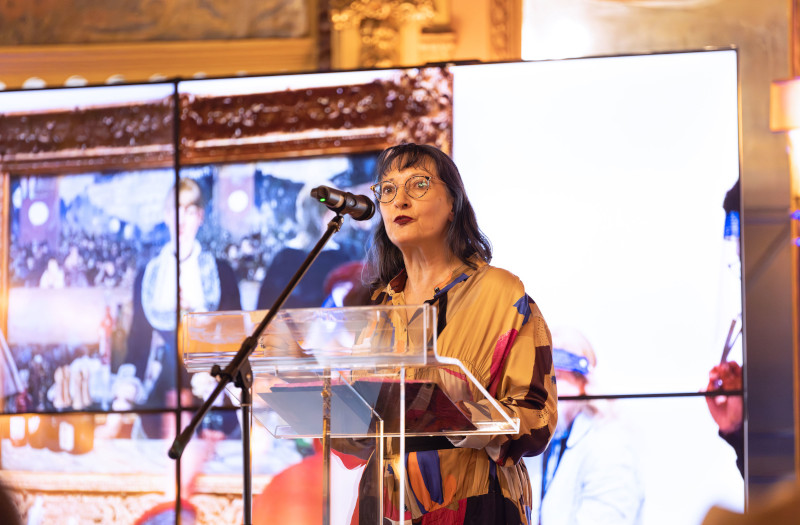
© João Inocêncio Gomes/Institute for Art and Olfaction
Similar mechanisms, specifically museological, were briefly presented by Sofia Ehrich, American art historian and exhibition curator associated with the Odeuropa project and co-author of the highly useful Olfactory Storytelling Toolkit, a practical guide for arts institutions interested in olfactory culture. British perfumer and author Sarah McCartney followed up with a summary of the project she recently ran with a group of students at the Courtauld Gallery in London: imagining the odours that could have emanated from the collection’s masterpiece, A Bar at the Folies-Bergère by Édouard Manet. Various visual elements from the paintings (drinks, candied mandarin, the crowd, etc.) as well as historical knowledge about perfumes from the 1880s resulted in the creation of six fragrances to be discovered on blotters during guided tours.
Various other practices notionally even further removed from perfumery were also highlighted during the event. Conjurer-turned-perfumer Michael Paul is interested in exploring the ties between the two practices which both rely on illusion and the “magic”, both of which he feels depend solely on public perception. His approach is therefore rooted in playing with expectations and attention, and fine-tuning the narrative to create an experience that really is out of the ordinary. Artist Klara Ravat, founder of the Smell Lab in Berlin, and perfumer Miguel Matos decided to talk about their playful and joyously “irrational” – to use their expression – experiments with olfactory composition. To take one example, the two partners came up with the idea of collective creation sessions inspired by the exquisite corpse game, where each participant, professional or amateur, adds an ingredient to the formula. Other sessions introduce chance into the process by proposing to compose a perfume by drawing a tarot card, with each card teamed up to a raw material. An excellent way to demythologise perfumery and make the olfactory experience amusing and accessible!
Researchers with a good nose
One of the remarkable aspects of the Experimental Scent Summit is that it opens the door to a wide array of voices: artists, perfumers and experimenters in many different areas are joined by researchers whose work nourishes the relatively recent field of sensory studies. Alessandra Mondin, for instance, presented a passionate, innovative piece of research on the olfactory representation of queer characters in British and US films. They studied films and drama series from the 20th and 21st centuries, such as The Maltese Falcon (1941), Murder, My Sweet (1944), Carol (2015) and Killing Eve (2018-2022), looking at how queer characters, whether explicitly or implicitly designated as such, are often associated on screen with a range of scented references and moments, while heterosexual masculinity is generally only associated on the olfactory level with cigar and cigarette smoke.
Historian Lily McGonigal, whose interests lie in art and fashion rather than film, was invited to share her research at the event. The researcher talked about her choice to combine perfumes, mostly from niche brands, with various surrealist works of art to underscore for her students the movement’s protean obsession with eroticism and the female body. She is convinced that the olfactory educational experience has a positive impact, seeing it as a way to engage students more strongly. She also argues for its relevance in terms of both her discipline – “Fashion history is the history of the traces our bodies leave behind” – and the multi-sensorial sensibilities of many of the artists in the surrealist movement.
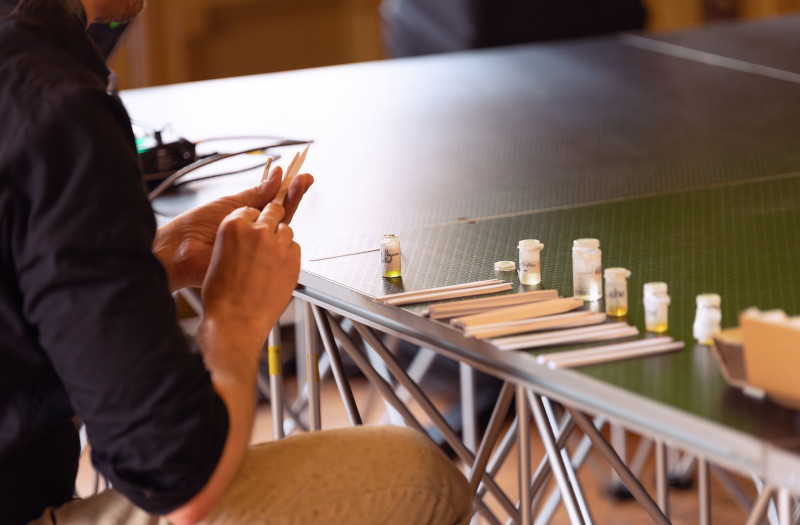
© João Inocêncio Gomes/Institute for Art and Olfaction
A member of the Institute of Organic Chemistry and Biochemistry at the Czech Academy of Sciences, Laura Prieto summarised the challenges posed by attempts to recreate ancient perfumes, an increasingly popular approach, from the perspective of both experimental archeology and arts institutions. The difficulty of using certain ingredients that have been lost or are almost impossible to find in their original form, environmental changes that can have an effect on the availability or olfactory profile of certain natural materials, and the lack of understanding of ancient techniques which cannot always be reproduced with modern equipment are some of the reasons the researcher cited as she argued that it is impossible to claim to reproduce perfumes from the past in identical form.
Philosopher and historian Sean Coughlin, a member of Alchemies of Scent, the multidisciplinary research group based in Prague studying perfumery in ancient Greece and Egypt, took a step away from his specialist field to share his ideas on one of the most famous, and controversial, figures of contemporary perfumery: François Coty. After a reminder of the darker aspects of Coty’s heritage, particularly his fascist affiliations and support for nationalist and anti-communist organisations, the researcher talked about the mysterious origins of the name of one his most celebrated fragrances, L’Origan (1905). He retraced its roots back to the Greek myth of Amaracus, the royal perfumer of Cyprus, turned into a marjoram plant (Origanum majorana) by Aphrodite. He pointed out that examining these strands of ancient and modern history is also interesting “because these stories, real and mythical, continue to affect the way we consider perfume and perfumery.”
Perfumer Matthew Sànchez shared an equally trans-historical perspective with the summit audience, investigating how perfumes are used in Mesoamerica. He cited the range of olfactory practices (social, spiritual, medicinal, hygienic, etc.) of the pre-Columbian peoples, focusing on a number of aromatic materials, from copal resin to cacao, prickly pear to eucalyptus as well as certain varieties of lily and star jasmine, before linking them to today’s olfactory practices in modern-day Mexico, which continue to be highly diverse. A long history which has influenced contemporary perfumery, since certain creators, such as Matthew Sanchèz himself, continue to draw on it to compose their own fragrances.
Exploring certain aspects of her cultural heritage, artist Maki Ueda, who has recently began to focus on more academic research, proposed a case study on “olfactory meta-communication” inspired by a classic work of Japanese literature: The Tale of Genji (11th century), attributed to Murasaki Shikibu. “What can we, as humans, communicate through odours?” asks Maki Ueda. By combining different incense compositions based on traditional recipes associated with specific moments and key characters from The Tale of Genji, she succeeds in illustrating the way in which perfume can add a new layer of meaning to the narrative and to all forms of communication, on the explicit condition that a form of common “olfactory literacy” enables a shared interpretation.
To come back to our modern Western culture, I myself presented my latest research project, at the crossroads of life sciences and environmental philosophy. I underlined the importance of rekindling our capacity to perceive and interpret the odours of the living world in a de-anthropocentric manner, encouraging us all to pay attention to the smells emitted by plants, mushrooms, animals and even bacteria, remembering that they are always the sign that something is happening or being exchanged within the fabric of life. I believe that making mindful, deliberate and informed use of our sense of smell when it comes to the living world would give us a conscious experience of air as a shared habitat and trigger a crucial reconnection with the rest of the biotic community.
The Art and Olfaction Awards turn 10
This busy day dedicated to olfactory culture in all its facets was followed the next evening by the Art & Olfaction Awards ceremony. A highpoint in the independent perfumery calendar, the awards celebrated their tenth anniversary this year. Prize winners in the Independent category were Amnesia Rose by Luca Maffei for Aedes de Venustas and IV by Kévin Mathys for Kajal. The Artisan category saw prizes going to Grove in the Heart by Na-Moya and Debbie Lin for Samar and Cocktail Molotov by Sy Truong for Sylhouette. Other award-winners were Arabian Jasmine by Amer Al Radhi for Amer Perfumes, which won the Aftel Award for Handmade Perfume, and Queer de Russie by Ksenia Golovanova and Valery Mikhalitsyn for Nose Republic which won the Newcomer Award.
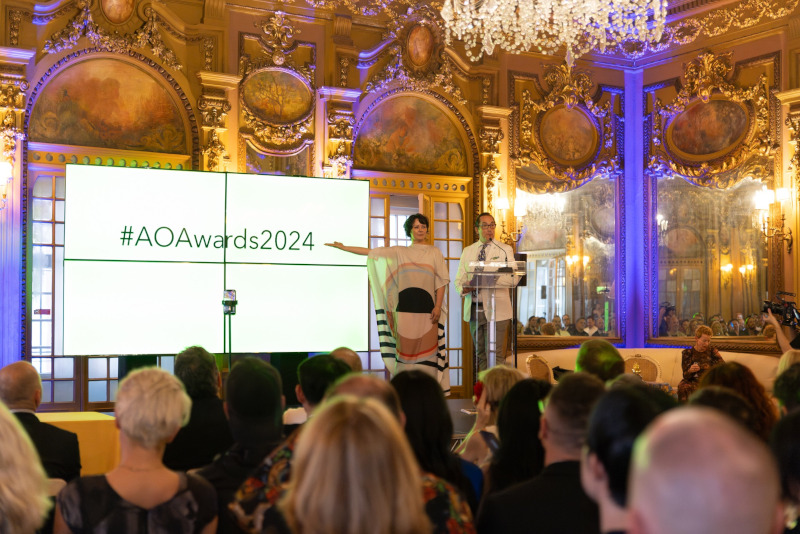
© João Inocêncio Gomes/Institute for Art and Olfaction
Artists Jas Brooks and Pedro Lopes won the Sadakichi Award, which recognises creative olfactory practices, for their project Smell and Paste. Their low-fidelity prototyping toolkit gives human-machine interface designers (particularly in the virtual reality field) a simple way of testing the efficacy of the chosen olfactory interaction thanks to scratch and sniff stickers pasted in the required order onto a paper tape which unwinds in a 3D-printed or cardboard cassette, releasing the smells in sequence. “We posit that designers need both hi-fi hardware for final development and low-fidelity prototyping techniques to make olfactory experience design quick, low-cost, and approachable,” explain the two project developers.
The jury also awarded prizes to the Odeuropa project for its contribution to scent culture, and British perfumer Pia Long, who won the Septimus Piesse Award for her work over recent years on furthering discussions between perfumers from across the globe and IFRA with the goal of championing perfumers’ creative freedom. A programme and an array of winners that fully reflect the Institute for Art and Olfaction’s founding mission to “foster experimentation and access in the field of perfumery, olfactory art, and other expressions with scent.”
Main visual: Maki Ueda during her presentation Possible Olfactory Meta-communication at the 5th Experimental Scent Summit, Casa do Alentejo, Lisbon. © João Inocêncio Gomes/Institute for Art and Olfaction
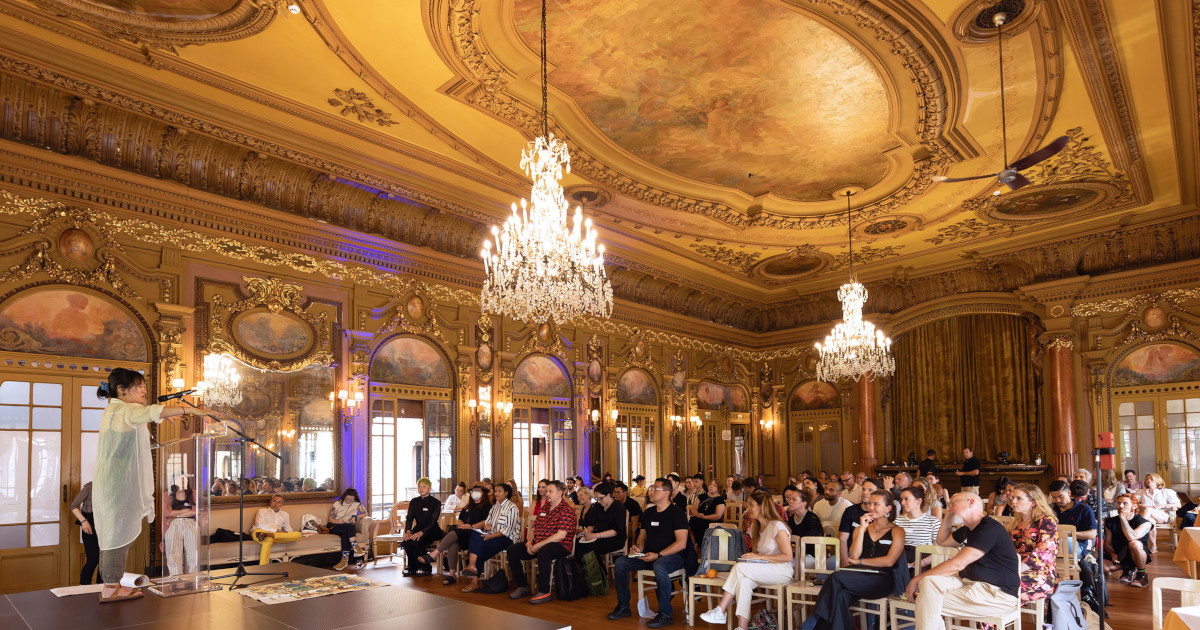
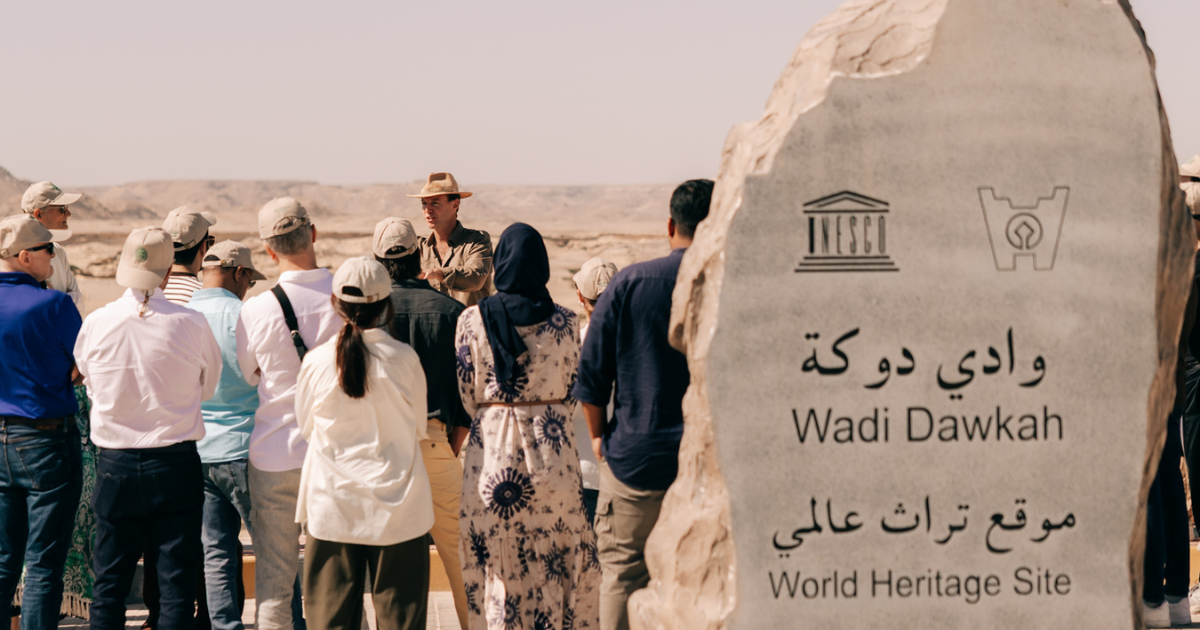

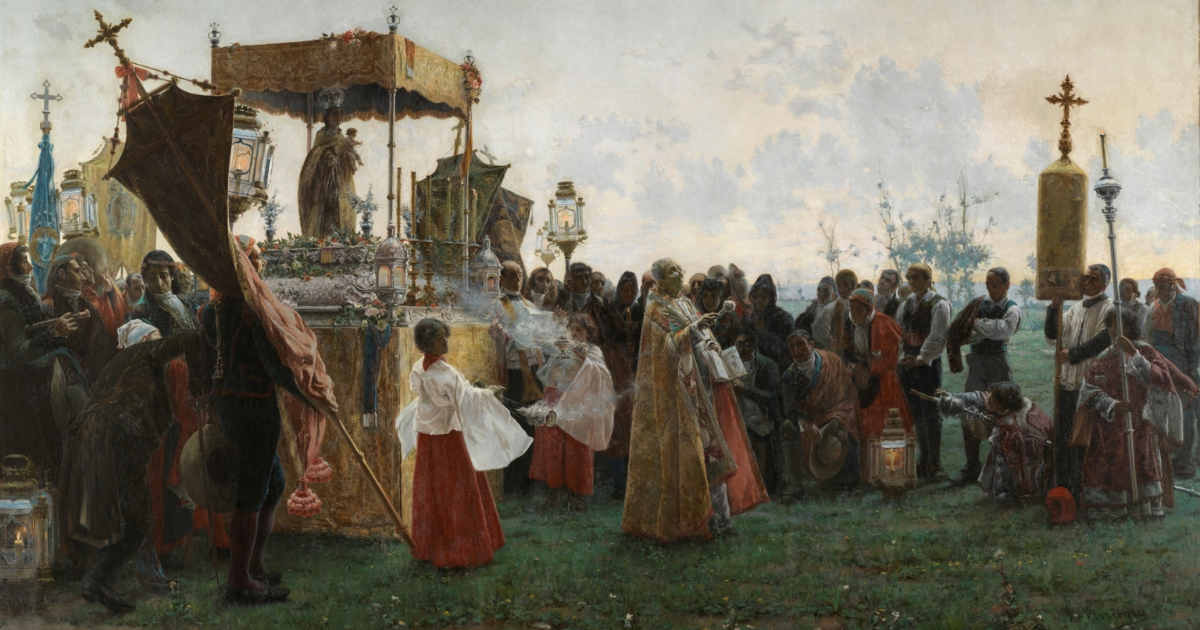
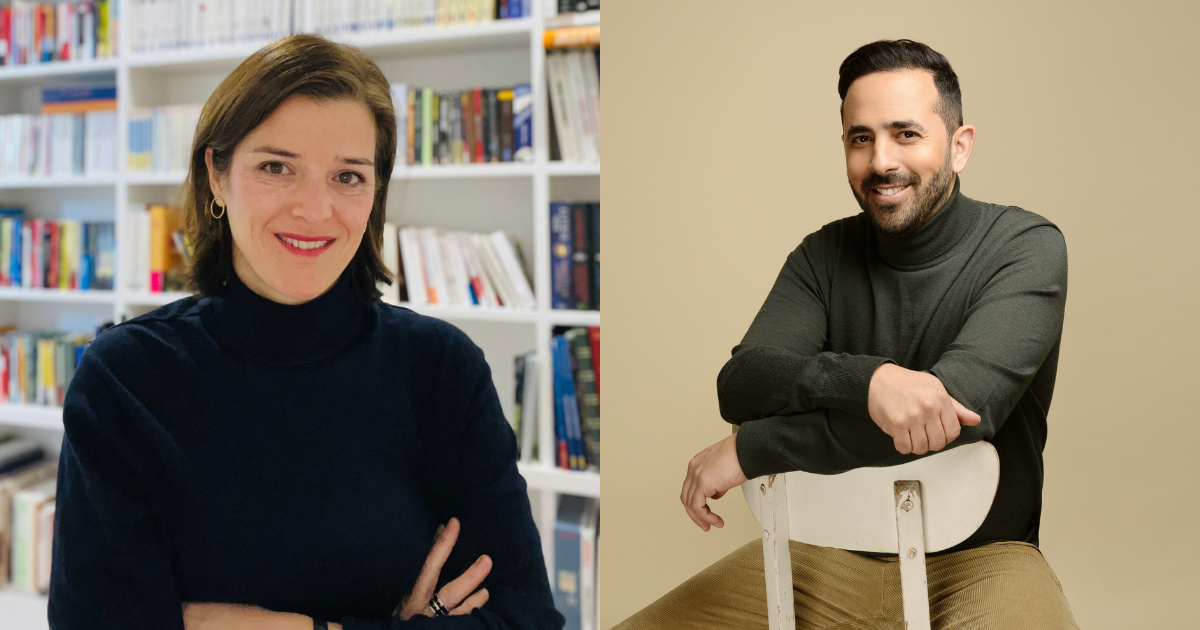



Comments